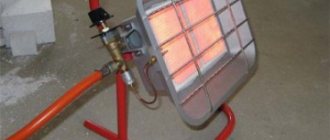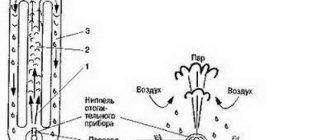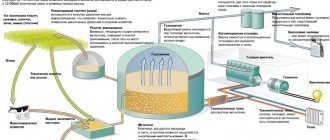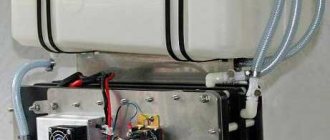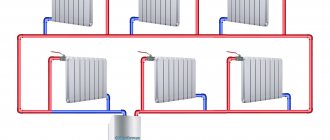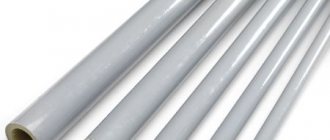Method 2 - tubular electric heaters
They transfer heat from a tubular electric heater to a liquid-based coolant. Typically, water and oil are used as a coolant, and sometimes antifreeze. The design principle of heaters is the same as that of electric kettles, which is why they are also called heaters and oil radiators. In fact, it is a boiler placed in a vessel with water. The efficiency of such devices is quite high, and heat loss for heating is minimal.
pros
- The undoubted advantages of tubular heaters include their safety, operational reliability and versatility of use.
- Can be used in both gaseous and liquid media.
- Not explosive, and not afraid of vibrations and shocks.
- Tubular heaters are available in a variety of design solutions, which allows you to economically heat a private home with electricity without disturbing the aesthetics of the interior.
Minuses
Heating heating elements have a high cost due to the expensive metals that are used in production. Since scale forms on the pipes, it is necessary to take care of the quality of the water.
A tubular radiator is a thin-walled metal tube with a spiral inside, so if you do not need particularly high temperatures, then you need to take a heater with carbon steel tubes. If the device must produce a consistently high temperature or operate in an aggressive environment, then you need to take a device made of stainless steel.
The photo shows a tubular electric heater made by yourself
What is a heating system without pipes?
Heating with a heat accumulator from expert engineers with 9 years of experience
Pumpless heating system
Today we’ll talk about a pumpless heating system
We need to make a pumpless heating system, also called “gravitational”, which will work in conjunction with our heat accumulator. Why did I decide to bring up this topic?
We now have a corona virus, many customers, especially those who are older, are really afraid that hard times will come to us and the electricity will be cut off. Just in case, they want their home to be warm and the heating to work when there is no light.
Is such a heating system even necessary in a modern home?
Immediately anticipating the most pressing question. Do we really need such a heating system in our house? In a modern home, I mean Moscow and the Moscow region, no, such a system is absolutely unjustified. This is for those who don’t want to read to the end, but I still recommend doing so, because I will show with real examples how it all works and there will be useful information at the end
Autonomous gasification: an expensive pleasure
Heating with liquefied gas is exactly the option that needs to be considered in special, exceptional cases: not only is the fuel itself quite expensive, but you will also need to install a massive gas tank, the cost of which depends on its volume; in general, gasification costs can be quite significant.
Heating with liquefied gas will require the installation of a gas holder
You can, of course, use small cylinders for heating, but this is inconvenient for a number of reasons, especially in large houses where people live constantly and not from time to time. Thus, autonomous gas systems cannot be called a popular way of organizing heating.
The PLEH heating system can be purchased in the following cities of the Russian Federation:
Arkhangelsk, Barnaul, Belgorod, Beloretsk, Blagoveshchensk, Bratsk, Bryansk, Vladivostok, Volgograd, Voronezh, Yekaterinburg, Izhevsk, Irkutsk, Kazan, Kemerovo, Kirov, Komsomolsk-on-Amur, Krasnodar, Krasnoyarsk, Kurgan, Magnitogorsk, Moscow, Murmansk, Nizhny Novgorod, Novy Urengoy, Novokuznetsk, Novorossiysk, Novosibirsk, Norilsk, Noyabrsk, Omsk, Orenburg, Penza, Perm, Petropavlovsk-Kamchatsky, Rostov-on-Don, Samara, St. Petersburg, Saratov, Sochi, Sterlitamak, Surgut, Syktyvkar, Tomsk, Tolyatti, Tyumen, Ulan-Ude, Ulyanovsk, Ufa, Khabarovsk, Khanty-Mansiysk, Cheboksary, Chelyabinsk, Cherepovets, Chita, Yuzhno-Sakhalinsk, Yakutsk and the list is constantly expanding.
Choosing a pellet stove
Let's immediately identify two main types of heating devices that use pellets as fuel:
- Boilers with the ability to heat the coolant. The portal Rmnt.ru devoted separate articles to the selection of solid fuel boilers, as well as their installation; we will not repeat them. Such equipment is quite bulky and requires installation in a separate room - a boiler room;
- In this article we are interested in pellet stoves-fireplaces. They heat air, not water, and can be installed in residential premises, replacing wood-burning fireplaces, compact and visually attractive. There are fireplace stoves with a water circuit, but, again, their dimensions exceed the standard ones.
You can choose a stove that runs specifically on pellets, or you can choose a partially combined stove, in which firewood will serve as an addition. Fully combined stoves operating on different types of fuel have several fireboxes, they are quite bulky and are rarely used indoors.
By type of burner, pellet stoves are divided into:
- Flare. A very popular household option. Convenient and easy to use, reliable. But the power is low and there are high requirements for fuel quality;
- Fireplaces. Pellets burn in a special bowl. The equipment is very quiet, safe, perfect for residential premises. But there are fewer possibilities for adjusting the operation of the stove; the requirements for the quality of pellets are also high;
- Volumetric combustion. They are most often used in massive industrial-type boilers, but are also occasionally found in domestic boilers. Powerful, undemanding to the quality of granules, but more bulky.
When choosing a pellet stove, you need to be guided by the following criteria:
Power. We have already written that 1 kW per 10 square meters is required if the height of the room does not exceed 3 meters. This is the number you need to start from when choosing a stove for a specific room or the house as a whole; Type of granules. Pellets are different! Make sure that you can definitely get the type of fuel used for this stove model, and it’s nearby and inexpensive; Fuel consumption . On average, you need a ton of pellets per month if no other heating is used in the house; Whether the fuel is loaded horizontally or vertically, consider which option is more suitable for you. According to user reviews, it is more convenient to pour pellets into a special bunker from above; Heat exchanger material. It is best if it is made of thick, high-quality steel. Cast iron is heavier and has greater thermal inertia; Manufacturer
Is there a warranty for the oven? Service maintenance? It is important; Fuel supply type. Manual, semi-automatic, fully automatic
If the fireplace stove serves more for beauty and heating of one room, you can throw pellets manually. In all other cases, it is better to choose a model with automatic filling of the required amount of granules into the firebox.
Pellet stoves have many advantages:
- Efficiency is at least 75%, reaches 90%;
- The granules burn almost completely, there is no need to frequently clean the ash pan;
- The fuel is environmentally friendly, there are no harmful substances in pellets;
- Granules are used sparingly;
- Heating is autonomous. If there is an automated system, a person does not need to control the combustion process;
- Independence from central heating supply;
- The equipment is modern and safe;
- There is no need to coordinate the installation of a pellet stove with any regulatory services;
- Fireplace stoves look aesthetically pleasing and fit perfectly into any interior style.
Among the disadvantages, we can only note that in Russia it is still difficult to get high-quality pellets of a certain type. In addition, the pellet stove must be connected to an electrical network, without which the ignition systems, pellet supply systems, and control unit will not work.
Another disadvantage of pellet stoves is their high price. Starts from 100 thousand rubles for the simplest and low-power models. And it can reach one million rubles. Popular brands of pellet stoves in our country are Termal (Macedonia), Gran, La Nordica, Castelmonte.
Video on the topic:
Heating a house with a traditional stove
Stove heating is still in demand today, since the operation of the stove does not depend on electricity, the presence of a gas pipeline or liquid fuel. Buying firewood in rural areas is not a problem; there is plenty of space for storing logs and logs. Most often, heating a country house without gas, using wood or coal, has two purposes - the actual heating of the premises and cooking. In order to be able to cook on the stove, the firebox is equipped with a special cast-iron stove with removable dampers.
One of the advantages is that the stove is the most primitive device in operation, and care for it is appropriate. The chimney and ash pan need to be cleaned. If the stove is heated with wood, then the chimney is cleaned once a month, if with coal, then the chimney can be cleaned once during the entire heating season - it depends on the brand of coal. Anthracite and semi-anthracite are hard, high-calorie grades and leave little soot behind. Smoked coal has a high ash content, and you will have to clean the chimney every few weeks, just like when using firewood.
To build a stove in a house, you need refractory bricks, sand and clay. Metal parts are grate bars, valves, doors for loading fuel and cleaning the ash pan, and a stove for cooking. The design of the Russian stove also provides a sleeping place. The Russian stove differs in design from a conventional stove - it retains heat longer, and at the same time it is more convenient to cook food. A Russian stove can be used not only as a heating device, but also as the main element for decorating a classic interior in the Russian classical style.
Furnaces of any design also have disadvantages. When burning wood, you need to load it constantly - once every 3-5 hours. Coal burns longer, but the stove will have to be loaded 2 times a day. Since the stove is almost always built in a residential area, dirt and debris will have to be removed constantly. Like cleaning the ash drawer every day, and cleaning the chimney several times throughout the heating season. The fire hazard of the structure is also high; there is a risk of carbon monoxide poisoning if used incorrectly. In addition, the furnace takes up much more space than a boiler or boiler. If you do not use water heating with the stove, the heating of the rooms will be uneven.
Gifts of nature: heat pumps and solar collectors
From the point of view of alternative, endless energy sources, these methods, or rather equipment for heating a house, can be called the most preferable and unique - especially if we talk about the second option (solar collector). It is quite possible to establish its operation even without the use of electrical energy. Let's look at these methods of heating a house without gas in a little more detail.
Heat pumps. They work on the same principle as the refrigerator in your kitchen, only in reverse.
Notice the heated radiator of the refrigerator on the back side. It is this heat, only on a large scale, that the heat pump produces
Such devices can extract thermal energy from the ground, water and even from the air. This system is good for everyone, but it would be much better if it did without electricity and did not require enormous costs for its production - unfortunately, this is the scourge of all non-volatile systems of our time. Among other things, such heating systems will require the creation of a whole complex of equipment. This includes an extensive system of underground pipelines that absorbs the heat of the earth (it is the earth-water heat pump that is by far the most efficient equipment of this type), the heat pump itself, heat accumulators and a lot of additional equipment, for which you will have to allocate a separate room of considerable size.
More attractive in this regard is the heating system of a country house without gas, which is based on a solar collector. There are quite a lot of advantages of such a system, but the most important of them is the ability to create energy-independent heating at home. Ask how? It’s quite simple, and the principle of such a system, again, is the natural circulation of the coolant. Such a heating system is divided into two circuits using a heat exchanger, in which the primary circuit transfers heat to the secondary circuit, which directly heats the house. In the first circuit, which uses a solar collector made of vacuum tubes, natural circulation is achieved due to the vertical position of the device. The cooled liquid in the heat exchanger displaces the heated liquid in the collector, sending it in this way to the same heat exchanger - the coolant circulating in a similar way heats the liquid in another circuit, in which exactly the same circular circulation occurs. You may ask why you can’t immediately heat the liquid in the heating system? The answer is simple - there is a lot of it, and the efficiency of the heating system will be very low. That is why the principle of heat exchange between the small and large circuits is used - in the small circuit the liquid does not have time to completely cool down, and it only has to be heated. Such systems also work effectively in winter.
Again, it should be noted that systems using an alternative energy source are expensive to install. In particular, you will have to pay a lot of money for the solar collectors or heat pump themselves. And the heating system itself will also be expensive. So, whatever one may say, the simplest and cheapest source of energy is still carbon in solid form. Although, who knows, maybe you will be able to assemble an effective collector with your own hands, spending almost no money on it.
And to conclude the topic about heating a country house without gas, I’ll say a few words about the rational use of energy. I probably won’t open the eyes of many people to the fact that the same fuel can simultaneously not only heat a house, but also supply it with hot water. For these purposes, solid fuel boilers are equipped with an additional circuit and a heat accumulator, and solar systems and a heat pump are equipped with an additional heat exchanger and a tank for storing heated water.
Author of the article Alexander Kulikov
Features of using solid fuel units
If you decide to make combined gas-wood heating, then you need to know some installation features of the equipment. Of course, its installation must be entrusted to specialists, but you must think ahead and prepare a place for it. So, despite the relatively small dimensions, each of them will take about 1.5 m2. It is important to take into account that these boilers are heavy. Before installing them in the room intended for them, it is advisable to pour a “cushion” of concrete. Also in the boiler room there must be a chimney into which combustion products will be discharged. A special air intake duct is also required.
The necessary additional equipment also takes up space. So, simultaneously with the boiler, a circulation pump and an expansion tank are installed. Most models of solid fuel boilers are equipped with several outlets. You can connect not only heating radiators and hot water to them, but also a “warm floor” system, heating swimming pools, winter gardens and other objects.
Personal experience
I use four heat sources to heat my house: a gas boiler (main), a fireplace with a water circuit, six flat-plate solar collectors and an inverter air conditioner.
Why is this necessary?
- Have a second (backup) heat source if the gas boiler fails or its power becomes insufficient (severe frosts).
- Save on heating. Using different heat sources, you can control the monthly and annual gas consumption rates so as not to switch to a more expensive tariff.
Some statistics
The average gas consumption in January 2021 is 12 cubic meters per day. With a heated area of 200m2 and an additional basement.
| October | November | January | |
| Expense per month | 63,51 | 140 | 376 |
| Minimum | 0,5 | 0,448 | 7,1 |
| Maximum | 5,53 | 10,99 | 21,99 |
| Average per day | 2,76 | 4,67 | 12,13 |
Fluctuations in consumption by day during the month are associated with different street temperatures and the presence of the sun: on sunny days the collectors operate and gas consumption decreases.
Homemade “warm baseboard” system for pennies
At the end of the article, a brief overview of another energy-independent and inexpensive heating system, RuslanaM. This is a gravity-fed “warm baseboard”.
RuslanM
I assembled the system myself, for a minimum of money. The system is gravity, single-pipe. No batteries. The solid fuel boiler was installed in the basement. How I did it:
- I took a two-inch diameter steel pipe. I laid it around the perimeter of the house, along the wall, where the baseboard should be.
- Withstood the minimum slope for gravity flow of water.
- System with an open tank and a Lemax Forward solid fuel boiler, power 12.5 kW. I bought a boiler, a thermostat, and two spare grates for 14 thousand rubles.
- I assembled the branch without cranes. The pipe was welded by electric welding. Some joints and turns were mounted on rivets. Thread on aerobic sealant. Not a single leak!
- The volume of water in the system is 80 liters, in the boiler 22 liters.
- Behind the refrigerator, where heat is not needed, the pipe was insulated.
The system works like this:
- The boiler, using a thermostat, maintains the desired temperature. If it’s frosty outside and the pipes cool down faster, the boiler’s vent opens.
- The boiler is fired with anthracite coal. One incomplete filling of fuel is enough for 24 hours of operation. Only once a day do you need to clean the grate.
- The boiler temperature is set to +70 °C. This is enough to maintain +22 °C in the house, and evenly, from floor to ceiling.
- Safety system if the boiler boils - a large volume of coolant in the system and an open expansion tank.
Heating systems used in modern conditions
The refusal to use electric heating systems is obvious, because this is the most expensive type of energy. The efficiency of electric heating devices remains low at high power consumption, and in private houses heat loss is always higher than in apartment buildings. In addition to these conditions, it is necessary to take into account the need to install a special boiler room, its and other problems.
Stove heating
For obvious historical reasons, the most popular method of heating premises is the stove. The classic version assumes that a stone stove installed in a specially designated area heats a room or group of rooms. The heat source in this case is burning solid fuel, which heats the stone structure. Having high inertia, that is, retaining heat for a long time, such a stove gradually warms the room over several hours.
The efficiency of such furnaces depends on several factors:
Construction of furnaces is a complex technological process; amateurs cannot do it, so it is imperative to involve an experienced craftsman, at least as a consultant.
Water heating with the construction of a furnace
The stove can be an independent source of heat, but it can also serve as a heater in a water heating system. In large houses or two-story cottages, this option is impossible without the use of a water pump, which runs on electricity and drives water through the system. If the length of the pipes is small, and the radiators have a pipe cross-section of 32 mm and above, then it is possible to arrange without gas and electricity with natural circulation.
The operating principle of such a heating system is known to many rural residents. Inside the furnace, in an area close to the burning fuel, a manifold welded from thick-walled metal pipes is mounted, in which water is heated. According to the laws of physics, hot water rises upward through a specially equipped pipe. Then it enters the heating pipeline, which is located with a slight slope, which is maintained throughout its entire length. According to the same physical laws, the liquid flows down, passes through the entire system, gives off heat, and ultimately ends up back in the collector inside the furnace, where the circle resumes.
Installation of such a system requires accurate calculation of the angle of inclination of the pipes and the presence of an expansion tank. The temperature of such heating can be controlled using valves that reduce the amount of hot water supplied to the system. In some cases, it is possible to install two or more heating circuits.
Fireplace heating
Fireplaces are more of a stylish addition to the interior than an effective source of heat. In order for a fireplace to heat at least a room, serious changes need to be made to its design and turned into a classic stove that only looks like a fireplace. In such a pseudo-fireplace, the shelf is retained, and the flame is covered with a door made of fireproof glass.
Alternative sources
Heating a private wooden house without gas or electricity using exotic sources such as solar panels and geothermal heat is of great interest to advanced owners. In both cases, certain climatic conditions are required. Geothermal springs are found in very few places on the planet, usually found in seismically active areas. For residents of 99% of Russia, this type of heating is not available.
Solar panels are mounted on the roof, since they require a large area to operate effectively. It is known that in winter snow falls, which will have to be cleared several times a day. In addition, in many regions in winter the daylight hours are so short that it is simply impossible to accumulate the required charge.
How to heat a country house without mains gas, money and electricity?
The question is both complex and simple. If money is short, then complex and expensive systems that require expensive equipment and hassle-free installation are not suitable for you. Electric convectors are also no longer needed. Although they are inexpensive and easy to install, they are demanding in terms of allocated electrical power. If you have 15 kW, then there are no questions, but if it’s less, or do the lights often turn off? So you can freeze! RuslanM offers a solution.
RuslanM
I built a warm house from permanent formwork. Pie walls - polystyrene foam - concrete - polystyrene foam. Area – 100 sq. m. There is a basement. I was wondering how to heat it. What was needed was a simple, cost-effective and power outage-resistant option. I decided that I would heat the house with gas convectors, which are powered by liquefied gas cylinders. I will also install a cast iron stove-fireplace. The advantages of such a system:
- Two systems - insurance against accidents and disasters.
- You won't freeze if the power goes out.
- Both options can be installed with your own hands and without spending money on specialists.
- By combining liquefied gas + solid fuel, you increase the overall operating time of the heating system.
For example, during the day, while you are at work, gas convectors work, and in the evening you light the fireplace and get pleasant warmth from a real fire.
Ruslan's house.
Gas convector.
Cast iron fireplace stove with ceramic chimney.
Looking ahead, we will say that Ruslan also installed an original homemade gravity heating system in the house, a “warm baseboard” with a “heart” in the form of a cheap solid fuel boiler. We will talk about it at the end of the article, and now, about the first two options. Go!
Heating from an autonomous source of electricity
You will learn how to heat a house without gas and electricity by carefully reading the article. If you want to save money and still be original, you can heat your home using solar energy. To do this, you need to buy solar collectors that are capable of converting the sun's energy into heat. At the same time, you can use an autonomous heater that works without electricity. Initially, you will have to spend money on purchasing the appropriate equipment, but during operation you will receive light and heat almost free of charge.
Are you still thinking about how to heat a country house without gas? You can also use technology that involves converting wind energy into thermal energy. To do this, experts recommend purchasing a ready-made device that is capable of converting mechanical energy into electricity. Many home craftsmen assemble such devices on their own. It is worth noting that such a unit is quite simple to implement; you will need to make a windmill by connecting it to a battery and a generator. Such methods of obtaining heat, according to modern summer residents, are extremely beneficial for country houses in areas where there are no gas pipelines. This is especially true for rarely visited properties.
Do-it-yourself autonomous heating without pipes
Clothes and shoes
Create a demotivator Get ideas and boldly get down to business! Continued below... ...
About the fur collar, which in itself, as an addition to the suit. Cute and practical. Besides, I suppose it’s quite possible to make some models yourself from a tired fur coat or faux fur. Simply chic 2. Fur + scarf and we have an addition to the sweater...
Modern models of women's dresses amaze with their diversity. But how to choose your ideal style, which will not only hide the flaws of the figure, but also emphasize its advantages? A-line dresses and sundresses are a unique solution for women of any age and body type. What's ahead...
Children's crafts
A beautiful doll can be not only a little girl’s favorite toy, but also an original decorative item. At the same time, it is not at all necessary to purchase a ready-made version, because you can make it yourself, taking into account your own preferences. https://www.youtube.com/watch?v…
According to the author. Surely all the handicrafts have long been busy preparing gifts for the New Year, because no matter how much you start in advance, it still comes suddenly. I am also preparing in an intensive mode. Just recently I hatched a woolly owlet, Filimonchik, and after him another, and another, and...
Surely all the handicrafts have long been busy preparing gifts for the New Year, because no matter how much you start in advance, it still comes suddenly. I am also preparing in an intensive mode. Just recently I hatched a woolly owlet, Filimonchik, and after him another, and another, and...
How are Christmas tree decorations made? Recently I was able to visit one of the factories producing glass Christmas tree decorations in Nizhny Novgorod and spy on this process. Do you want to watch it too? Before getting to the production itself, I suggest you admire the exhibition images…
Accessories
Felting or felting is a special and interesting technique for working with wool. This type of needlework allows you to create amazing designs on fabric and finished products, toys and decorative items. WHAT IS FELTING The essence of the technique is repeated piercing of wool with a special...
The heart of any woman begins to beat faster when she passes by a display case with jewelry... Graceful things are so pleasing to the eye. A little time and minimal effort is all it takes to create a unique piece of jewelry that will look amazing with almost any outfit. Seeing this...
1. 2. 3. 4. 5. 6. 7. 8. 9. 10. 11. 12. 13. 14. 15. 16. 17. 18. 19. 20. 21. 22. 23. 24. 25. 26. 27. 28. 29. 30. …
For home
On the site of this modern house with a laconic gray facade and a large glass area, quite recently there stood an ordinary village hut. However, it still exists. Moreover, the log house became the main accent in the interior of the Minsk designer’s country house. The village is 40 kilometers from...
Making a sofa that is roomy Source
Many people like to spend a free evening or day off reading their favorite books. In addition, real book lovers are constantly adding to their collection. And then the question arises, where to store this entire library, and so that later you don’t have to spend hours looking for the right book or not installing it...
Kitchen Tricks
Once you cook it once, you will become an eternal fan of this dish! All your guests will love it, and no one will leave your house until they ask for the recipe. waffle cake – 6 pcs. (120 gr.) herring - 1 pc. champignons – 300 gr. onions – 2 pcs. carrots – 350 gr. mayonnaise - …
An original New Year's dish that will surprise your family and guests! Coat the goose with a mixture of rosemary, thyme, salt and pepper and let it lie in the refrigerator for a day. Place 3-4 apples into the carcass, cut into slices, remove the grass and pepper from the skin, and brush with butter. But…
Everyone who lives in a “Khrushchev” knows firsthand what a tiny kitchen is. But you want everything to be convenient and functional. These 17 trending kitchen design ideas will prove that a small space is not a hindrance to style. 1. Vintage experiment Extravagant...
sdelaisam.mirtesen.ru
Liquid fuel boilers
You can heat your living space using equipment that runs on liquid fuel. Diesel is used as fuel. Such boilers are equipped with fan burners.
This device atomizes fuel and supplies it to the combustion chamber.
The device is equipped with a special regulator. It controls the appliances that are connected to the boiler. This could be a burner or a pump.
An important parameter of an oil-fuel boiler is power. This option requires preliminary calculation. This takes into account the number of window and door openings, the thickness of walls and ceilings.
A separate room is selected for installation of the liquid fuel boiler. It should have a hood and a place to store fuel.
To heat a house without gas or electricity, you need to equip the device with a special filter. This will prevent the injectors from clogging.
If the fuel needs to be replaced, the burner is reconfigured.
Diesel fuel equipment is characterized by noiselessness and performance.
Liquid fuel structures have high efficiency and can heat large rooms.
This system can be completely autonomous, which allows heating without gas or wood. No permits are required to install such a system. Such designs operate on various types of fuel and with any coolant.
When arranging equipment, it is worth considering the following features:
- Fuel costs increase compared to gas appliances.
- A container for storing fuel raw materials is installed in the room.
- A separate boiler room is being built. since the heating system is characterized by unpleasant odors.
- Electricity will be required, since when the power goes out, the backup generator must be started. In this case, you can heat your house without gas.
If we compare performance and characteristics, an oil-fuel boiler is on the same level as a gas boiler, differing only in the price of fuel and its types
Classic options
In regions where there is no gas and there are regular interruptions in the supply of electricity (in other words, the lights are constantly turned off), many people heat their homes using a conventional stove. This is the most budget option: erecting the structure does not take much time and does not require huge investments. It is built from bricks, clay, sand. Metal is also needed for grilles, doors, and valves.
But heating a house with a stove is quite a labor-intensive task. You need to regularly add fuel, remove ash, and monitor the heat. It is also important to organize a dry place to store fuel. The room in which the stove is installed will be constantly contaminated with soot during the heating season. But its main disadvantage is that it is not able to heat the entire building evenly.
Without using gas or electricity
Today, there are several alternative options for heating a room that do not require electricity or gas supply. Such heating from pipes without batteries will save money. Heating system options can be as follows:
- stoves and fireplaces. They heat the room using the energy of burning wood or coal. If you decide and choose this option, you will need to build a stove or purchase ready-made communications, which you only need to install correctly. At the same time, as a result, the family receives an environmentally friendly and economical method of heating, and if the stove is equipped with a frying surface, then it will cope with cooking food;
- an autonomous heating system from a personal source of electricity, which can be obtained in two ways:
- with the help of sunlight. Here you will have to spend money on special solar collectors that can convert solar energy into thermal energy and thus work as a heater. Naturally, you will have to invest in the purchase of equipment, but the expenses will be one-time, and the receipt of electricity will be constant;
- using the power and energy of the wind. To do this, you will have to build a special apparatus, which consists of a turntable, a generator and a battery. If you can’t assemble it yourself, you can purchase a ready-made structure that converts wind power into electricity.
Video 2. Heating without gas and wood. New!
Without pipes and boilers
An autonomous heating system is often equipped with a boiler to which pipe-radiator communications are connected, which make it possible to heat several rooms at once. However, properly selected heating without pipes and batteries, which operates from a single heat source, can work just as effectively. Most often this is:
- a stove made of brick or metal, which will be an ideal option for supplying heat to one room or two adjacent rooms;
- a fireplace, which was used in ancient times to heat castles;
- electric heater, reflex or oil-based;
- air conditioners, etc.
Remember that for a country house built according to the old “five-wall” principle, one stove, which is located in the middle of the house, is quite enough for high-quality heating. Even today, in such structures, heating is carried out without pipes, radiators and boilers.
Heating without fuel
It consists of pipes that are filled with freon, as well as throttle, compressor and heat exchange chambers. The device operates like a refrigerator and is based on simple physical laws.
The pipes are located deep underground or in a lake at a decent depth so that the ambient temperature does not rise above 8 0C even on the hottest day.
Already at 3 0C, freon boils and rises through them into the compressor, where it can be compressed and thus heats up to 80 0C.
In this form, it is sent back to the highway underground, repeating the cycle in a circle.
Warmth without heating
Even without a heating system, without pipes, radiators and boilers, it is possible to warm up the room.
There are several methods that are used both together and separately. These include:
- maximum insulation of your home. To preserve the particles of heat that come after cooking, breathing of residents, etc. It is enough to insulate the walls, add warm floor coverings to the interior, heavy curtains on the windows so that they block the access of cold air and do not allow heat to leave the room, etc. Even if the heating system works as it should, such nuances will allow you to save energy resources and not consume more heat than necessary;
- insulation of home wardrobe. Wear a warm sweater and slippers. While watching TV, cover yourself with a warm blanket or use a warm cape, a heating pad in bed and warm drinks (tea, milk);
- psychological heating. We change the design of the room, its color scheme to a warmer one (peach, yellow), add knitted decorative elements and wooden accessories. Use scented candles and photographs of warm countries in the interior. Thus, there is an impact in two directions: on the eyes and touch. This way you can deceive the body and make it feel warm.
In any case, you can find an opportunity and a suitable method to warm your home. Heating without pipes and boilers can be an effective solution to this problem even in severe frosts. Using the above methods, you will be able to warm your home even in the most unusual situations.
Types of structures
Heating circuit - elements used as a heating system by transferring thermal energy into the air. The most popular systems are those that use boilers or boilers connected to a water supply as a heating source. The liquid, crossing the heating elements, reaches the set temperature, heading into the heating circuit.
Coolant movement is ensured by two methods:
- natural;
- forced.
With forced circulation through pipes
Systems with natural movement of coolant are simple and reliable. Efficiency depends on the proper design of the heating circuit. In the latter case, a pump is introduced that creates pressure. The coolant moves through the pipeline.
Heat sources for heating liquids are boiler rooms and boiler equipment. The operating mechanism is based on the conversion of one type of energy into heat. Depending on the raw material and heating source, boilers operate on gas, solid fuel, electricity, or fuel oil.
All types of boiler units can be used to heat a private home. Gas and solid fuel devices are popular.
Depending on the connection of heating devices in the heating circuit, there are: single-pipe and two-pipe systems. Single-pipe system - when the batteries are connected in series, the water, crossing each element, returns to the boiler.
Single-pipe scheme
The downside is the uneven heating of the room. Each subsequent radiator receives less thermal energy.
In a two-pipe heating circuit, the batteries are connected parallel to the riser. The negative side of the system is the complexity of the design and high consumption of material. In multi-storey buildings, only a two-pipe heating system can be used.
Two-pipe scheme
Heating with electric boiler
An electric boiler is a compact device with high efficiency. Environmentally friendly operation, constant energy supply, ease of installation and operation are the main advantages of electric units. The coolant is heated using built-in heating elements. The cost of an electric boiler is comparable to the cost of gas equipment, boiler maintenance is minimal.
An electric boiler is a good, but expensive way to heat a private home without gas.
Disadvantages - the allocated electrical power is not always enough to fully heat the premises. If electricity is often cut off in a region, there is no alternative to heating. Although the cost of equipment and its installation are relatively cheap, monthly electricity bills in winter will be high.
Advantages and disadvantages of solid fuel boilers
A solid fuel boiler is a heating unit whose body is made of cast iron or heat-resistant steel. Thermal energy is released when burning coal, peat, wood or waste from the wood processing industry. The efficiency and safety of a solid fuel heating unit has been proven in practice. The premises are heated by coolant, which is poured into the heating system connected to the boiler.
The advantage of a solid fuel boiler is that it works on a variety of materials.
The advantage of such a device is that the fuel for it is inexpensive, and accordingly, the cost of thermal energy is low. 1 kW of heat generated by a solid fuel boiler is 4 times cheaper than 1 kW of energy generated by gas combustion, 8 times cheaper than using liquid fuel, 17 times cheaper than energy from an electric boiler.
The solid fuel boiler is non-volatile; it does not need to be connected to either the gas mains or electricity. If the boiler is equipped with automation, then most often it is an independent device. The unit is easy to install, operate and repair.
Among the disadvantages noted: the need to manually load fuel, the ash content of the fuel (which necessitates constant cleaning of the boiler and chimney), and the need for constant visual monitoring of the operation of the boiler. The large inertia of the unit is both an advantage and a disadvantage. The boiler takes a long time to warm up itself and warms up the heating system for a long time, but it also takes a long time to cool down, maintaining heat in the house.
Which heating method is better?
To calculate heat, two units of measurement are used - gigacalories (Gcal/h) and kilowatt-hours (kW/h). Also, regional authorities often use kilojoules (kJ) for calculations. Following generally accepted calculations in gigacalories, you can determine the cost of Gcal/h for any room. So, to heat a room of 150 m2, you need to spend 16 Gcal per heating season, or 2.5 Gcal per month. The price of 1 Gcal can be determined using a comparative method.
- For example, let’s take gas, the cost of 1 m3 in 2014 was 4 rubles. The calorific value of the network gas is the sum of the calorie content of the mixture that makes up the network gas. Therefore, the specific heat of 1 m3 of gas mixture ranges from 7500-9600 Kcal. Gas boilers have an average efficiency of 90%; as a result, we get the cost of 1 Gcal of heat in the range of 600-700 rubles. If there is no main gas, then bottled gas cannot solve the problem - the composition of the gas is different, and the equipment will have to be redone. When comparing the cost of 1 Gcal of propane-butane mixture (bottled gas) and the cost of natural gas, it is clear that the gas mixture is 4-5 times more expensive.
- The specific heat of combustion of liquid fuel is within the range of 10,000 Kcal/kg or 8,650 Kcal/l, since the density of liquid fuel is different, especially taking into account the time of year. The efficiency of a liquid fuel boiler is 90%. With the cost of 1 liter of diesel fuel being 33 rubles, 1 Gcal will cost 3,300 rubles. Conclusion - heating with liquid fuel will be expensive. Considering the trend of constant increase in prices for diesel fuel and fuels and lubricants, this is not the most economical way to heat a country house.
- Coal is a cheap fuel, and the efficiency of solid fuel boilers is often more than 80%. Anthracite is the most expensive brand of coal, and for heating your home you can use cheaper coal - DPK (long-flame, large stove), DKO (long-flame, large nut) or chicken coal. A ton of coal costs an average of 6,000 rubles. The specific heat of combustion of coal is 5300-5800 Kcal/kg. Calculations show that the cost of 1 Gcal when heating with coal will be 1200-1300 rubles.
- Using peat to heat your home will cost more. The specific heat of combustion of peat is 4000 Kcal/kg. This means that the cost of 1 Gcal is 1300-1400 rubles.
- Pellets are one of the types of solid fuel. Pellets are produced from waste from the wood processing industry in the form of granules. They are convenient to use in solid fuel boilers with automatic loading. The specific heat of combustion of pellets is 4.2 Kcal/kg. If the cost of pellets for 1 ton is 5,000 rubles per ton, the cost of 1 Gcal will be approximately 1,500 rubles.
- Electric energy is the easiest way to heat a house without gas. The efficiency of an electric heater tends to 100%. 1 Gcal is 1163 kW/h. Therefore, at the current price of electricity for a village of 2 rubles per 1 kW/h, 1 Gcal will cost approximately 1,600 rubles.
- You can reduce the cost of using electricity for heating by using a heat pump. The heat pump operates on the principle of a refrigerator - the refrigerant evaporates at low positive temperatures. The route is laid through thin long tubes in the ground or at the bottom of a natural reservoir. Even in extreme cold, correct calculation of the required depth for laying pipes will not allow them to freeze. Having reached the house, the refrigerant begins to condense and releases the heat accumulated from the water or soil into the heating system. The movement of the refrigerant is controlled by a compressor, which is powered by electricity. The average power consumption of a compressor is 300 W to generate 1 kW of thermal energy. The price of 1 Gcal of heat will be 880 rubles.
The conclusions are obvious and unambiguous - in order to organize economical heating of a country house without gas, it is best to use a heat pump or solid fuel in any form.


